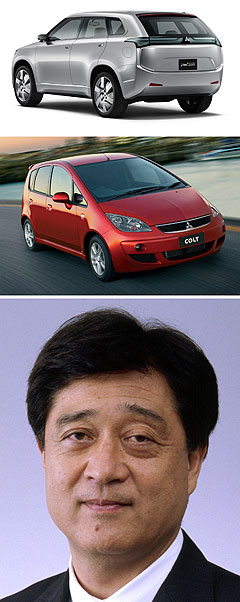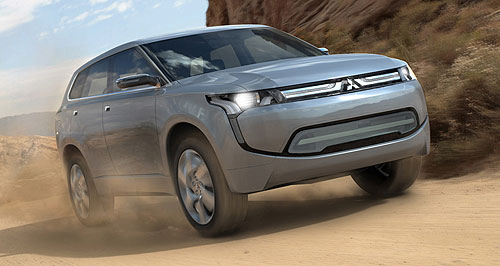Future models - Mitsubishi - OutlanderMitsubishi confirms plug-in hybrid SUVPlugged-in: PX-MiEV concept is expected to morph into next-generation Outlander hybrid. Plug-in hybrid SUV and new 'Global Small' car to come to Oz from Mitsubishi by 20132 Jun 2010 MITSUBISHI has revealed it will produce a plug-in hybrid SUV based on the PX-MiEV crossover concept and an all-new 'Global Small' car with electric drive to replace the slow-selling Colt by 2013, both of which will be sold in Australia. According to Mitsubishi Motors Corporation's global chief Osamu Masuko, in his first visit to Australia as president of Japan's sixth-largest car-maker, Mitsubishi will also introduce electric variants of all its small cars and plug-in hybrid versions of its SUVs in future. “Environmentally, MMC has a strong advantage over our competitors,” he said in Sydney this evening, after travelling to Canberra to announce the limited release of the first examples of Mitsubishi's pioneering i-MiEV micro-EV in Australia next month. “Already we have launched the first mass-produced electric vehicle in the i-MiEV, and we are on track to launch our first plug-in hybrid by 2013. “In response to consumer demand for smaller. More economical vehicles, we are developing a new model, called Global Small. This new vehicle is scheduled to be launched globally – including in Australia,” said Mr Masuko. While the all-new ‘Global Small’ model will come with all-electric and conventional internal combustion engines – likely to be in the form of 1.1 and 1.3-litre three-cylinder petrol engines – Mitsubishi’s all-new mid-size crossover wagon will be among a range of SUVs to also be available with plug-in hybrid power. GoAuto understands the production version of the PX-MiEV - the first Mitsubishi vehicle to emerge with a plug-in hybrid drivetrain – will emerge within three years as the replacement for the seven-seat Outlander compact SUV. As part of Mitsubishi’s new commitment to produce plug-in hybrid derivatives of its entire SUV model line-up – and its forecast that 20 per cent of its new vehicle sales will be all-electric or hybrid powered – plug-in versions of the Challenger and Pajero are also expected. It is not clear whether Mitsubishi plans an all-electric or a plug-in hybrid version of the ASX (known in Japan as the RVR), which will be the next cab off the brand’s SUV rank when it launches here in July. “Our popular SUV range will continue to be core products in our Australian line-up,” said Mr Masuko. “To address environmental concerns, we will continue to develop lower CO2 emission versions of these vehicles and in a few years’ time we plan to launch a new plug-in hybrid-based SUV.  From top: Mitsubishi PX-MiEV concept, Mitsubishi Colt and Mitsubishi Motors Corporation president Osamu Masuko. From top: Mitsubishi PX-MiEV concept, Mitsubishi Colt and Mitsubishi Motors Corporation president Osamu Masuko.“We will continue to introduce downsized and smaller products into the market. First of all we have the ASX, a small all-wheel drive that is economical, environmentally friendly and provides superior driving performance. “Then we will launch Global Small to the world market, an environmentally friendly car that provides an attractive entry point to the Mitsubishi Motors range. “I feel confident that our Australian operation can look forward to a strong, profitable and sustainable future in this country,” said MMC’s global chief today. The plug-in hybrid drive system of the PX-MiEV, which debuted at the Tokyo motor show last October, appears to be similar to the ‘Hybrid4’ system from PSA Peugeot Citroen, which has an established powertrain and EV product-sharing alliance with MMC. It combines a conventional internal combustion engine with two electric motors that enable alternative front-drive/rear-drive or simultaneous (all-wheel drive) operation and full-electric motoring over a limited (50km) range. In this case, an 85kW/125Nm 1.6-litre DOHC MIVEC petrol engine drives the front wheels and acts as a generator, with each permanent-magnet synchronous motor developing 60kW/200Nm front and rear. The system is designed to automatically switch to the optimum drive mode based on the driving conditions and the level of energy in the lithium-ion battery pack. According to Mitsubishi, the drive battery will power the front motor/front wheels at low to middle vehicle speeds, switching to the rear motor for four-wheel drive whenever traction wanes. The petrol engine automatically kicks in at higher speeds and when drive battery energy falls to a predetermined level, running in front-wheel drive but also reverting to four-wheel drive via the rear motor when required. More powerful systems are also likely to power future generations of the Challenger and Mitsubishi 4WDs. “The point is future SUV models will have a plug-in hybrid derivative,” said Mitsubishi Motors Australia Limited brand and marketing vice-president Paul Unerkov. “The plan is for successor models of all our small cars to have an all-electric component, and for larger models to have a plug-in hybrid component.” Mr Masuko said the forthcoming ‘Global Small’ car would be smaller and more affordable than the current Colt, which went on sale in Australia in September 2004. He said an EV version would join the range about a year after the launch of Global Small, which would effectively replace Mitsubishi’s current five-door light-car, which is the brand’s entry-level model in Australia but not Japan, where the petrol-powered i-car represents Mitsubishi in the domestic ‘kei-car’ class. "Vehicle sales in Japan, the US and Europe are not going up and in these countries we already have vehicles that are geared towards the environment. In developing countries we believe that the importance and sales of these vehicles will rise and that growth will be in small cars, so we decided to develop Global Small. "It is different to the (Tata) Nano. Nano is much cheaper," said Mr Masuko, who added that Mitsubishi’s shift towards hybrid models after it appeared the company had skipped what many describe as an interim powertrain technology was not a backflip but a natural progression. “We have 40 years of EV development behind us,” he said. “We decided to concentrate on EV in 2005 and after we launched it last year we recognised elements of the technology can also be applied to plug-in hybrid. “What we’re talking about is not a mild hybrid but a full hybrid with plug-in EV capability for all of our larger models. “(Our) Larger vehicles will be (offered with the choice of) petrol, diesel and plug-in hybrid. “Until now Mitsubishi’s strength has been in SUVs and that’s reflected in our brand image. So from now on we’d like to produce SUVs that are both sporty and environmentally friendly at the same time,” said Mr Masuko.  Read moreAll future models Alfa Romeo Alfa Romeo Abarth Abarth Audi Audi Aston Martin Aston Martin BMW BMW Bentley Bentley Chrysler Chrysler Chevrolet Chevrolet Dodge Dodge Citroen Citroen Ferrari Ferrari DS DS Ford Ford Fiat Fiat FPV FPV Foton Foton Haval Haval Great Wall Great Wall Honda Honda Holden Holden Hyundai Hyundai HSV HSV Isuzu Isuzu Infiniti Infiniti Jeep Jeep Jaguar Jaguar Lamborghini Lamborghini Kia Kia Lexus Lexus Land Rover Land Rover Mazda Mazda Maserati Maserati Mercedes-Benz Mercedes-Benz McLaren McLaren Mini Mini Nissan Nissan Mitsubishi Mitsubishi Peugeot Peugeot Opel Opel Proton Proton Porsche Porsche Renault Renault Ram Ram Saab Saab Rolls-Royce Rolls-Royce Smart Smart Skoda Skoda Subaru Subaru SsangYong SsangYong Tesla Tesla Suzuki Suzuki Toyota Toyota Volvo VolvoOutlander pricing
Motor industry news |
Click to shareMitsubishi modelsResearch Mitsubishi All future models Alfa Romeo Alfa Romeo Abarth Abarth Audi Audi Aston Martin Aston Martin BMW BMW Bentley Bentley Chrysler Chrysler Chevrolet Chevrolet Dodge Dodge Citroen Citroen Ferrari Ferrari DS DS Ford Ford Fiat Fiat FPV FPV Foton Foton Haval Haval Great Wall Great Wall Honda Honda Holden Holden Hyundai Hyundai HSV HSV Isuzu Isuzu Infiniti Infiniti Jeep Jeep Jaguar Jaguar Lamborghini Lamborghini Kia Kia Lexus Lexus Land Rover Land Rover Mazda Mazda Maserati Maserati Mercedes-Benz Mercedes-Benz McLaren McLaren Mini Mini Nissan Nissan Mitsubishi Mitsubishi Peugeot Peugeot Opel Opel Proton Proton Porsche Porsche Renault Renault Ram Ram Saab Saab Rolls-Royce Rolls-Royce Smart Smart Skoda Skoda Subaru Subaru SsangYong SsangYong Tesla Tesla Suzuki Suzuki Toyota Toyota Volvo VolvoOutlander pricing
Motor industry news |















Facebook Twitter Instagram